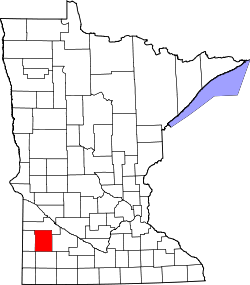Lyon County | |
|---|---|
 Student Center at Southwest Minnesota State University. | |
 Location within the U.S. state of Minnesota | |
 Minnesota's location within the U.S. | |
| Coordinates: 44°25′N95°50′W / 44.41°N 95.84°W | |
| Country | |
| State | |
| Founded | March 6, 1868 March 2, 1869 |
| Named after | Nathaniel Lyon |
| Seat | Marshall |
| Largest city | Marshall |
| Area | |
• Total | 722 sq mi (1,870 km2) |
| • Land | 715 sq mi (1,850 km2) |
| • Water | 7.1 sq mi (18 km2) 1.0% |
| Population (2020) | |
• Total | 25,269 |
• Estimate (2023) | 25,427 |
| • Density | 35.3/sq mi (13.6/km2) |
| Time zone | UTC−6 (Central) |
| • Summer (DST) | UTC−5 (CDT) |
| Congressional district | 7th |
| Website | www |
Lyon County is a county in the U.S. state of Minnesota. As of the 2020 census, the population was 25,269. [1] Its county seat is Marshall. [2]
Contents
- History
- Geography
- Lakes
- Major highways
- Airports
- Adjacent counties
- Protected areas
- Demographics
- 2020 Census
- 2000 census
- Communities
- Cities
- Unincorporated communities
- Townships
- Politics
- See also
- References
- External links
Lyon County comprises the Marshall, MN Micropolitan Statistical Area.


